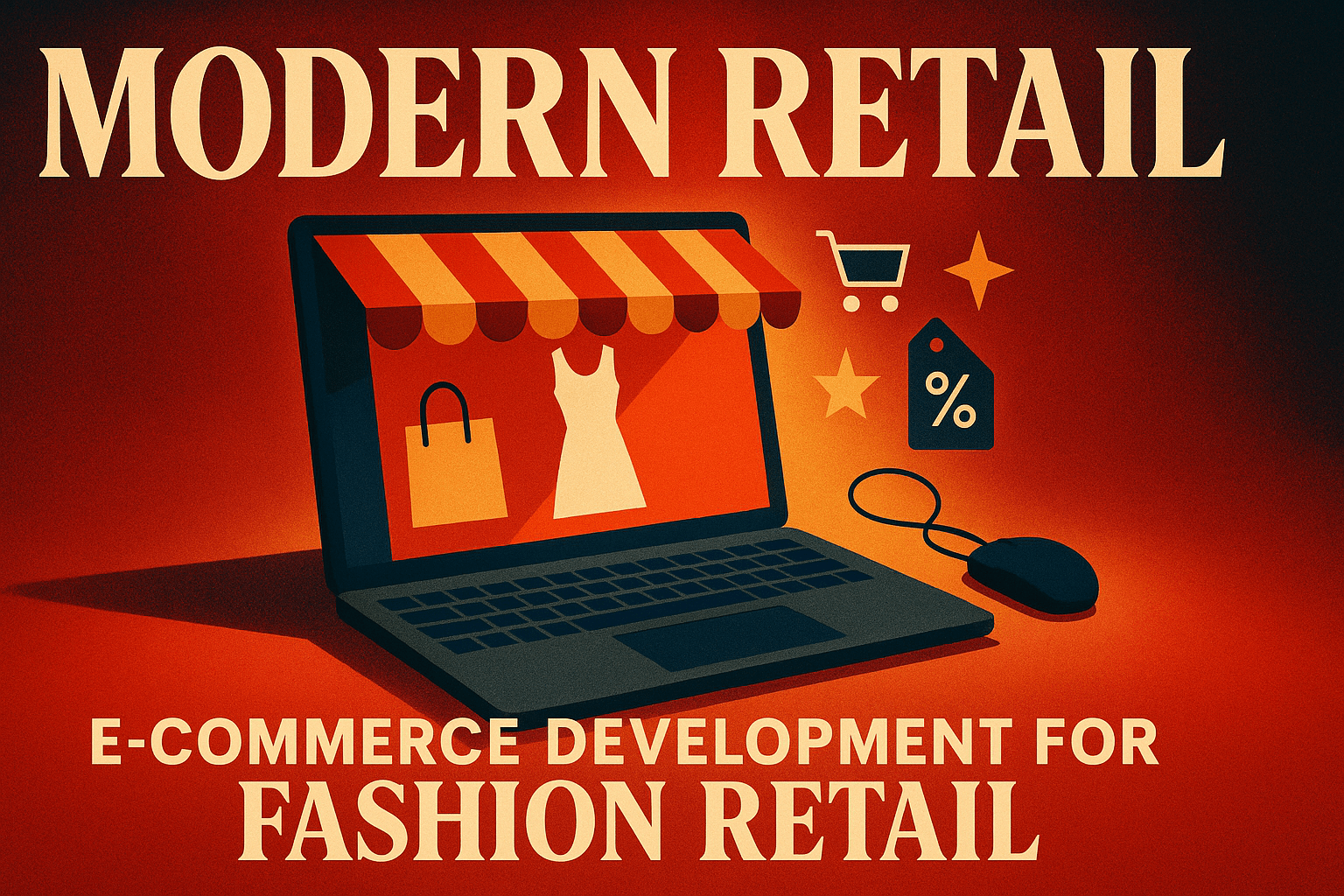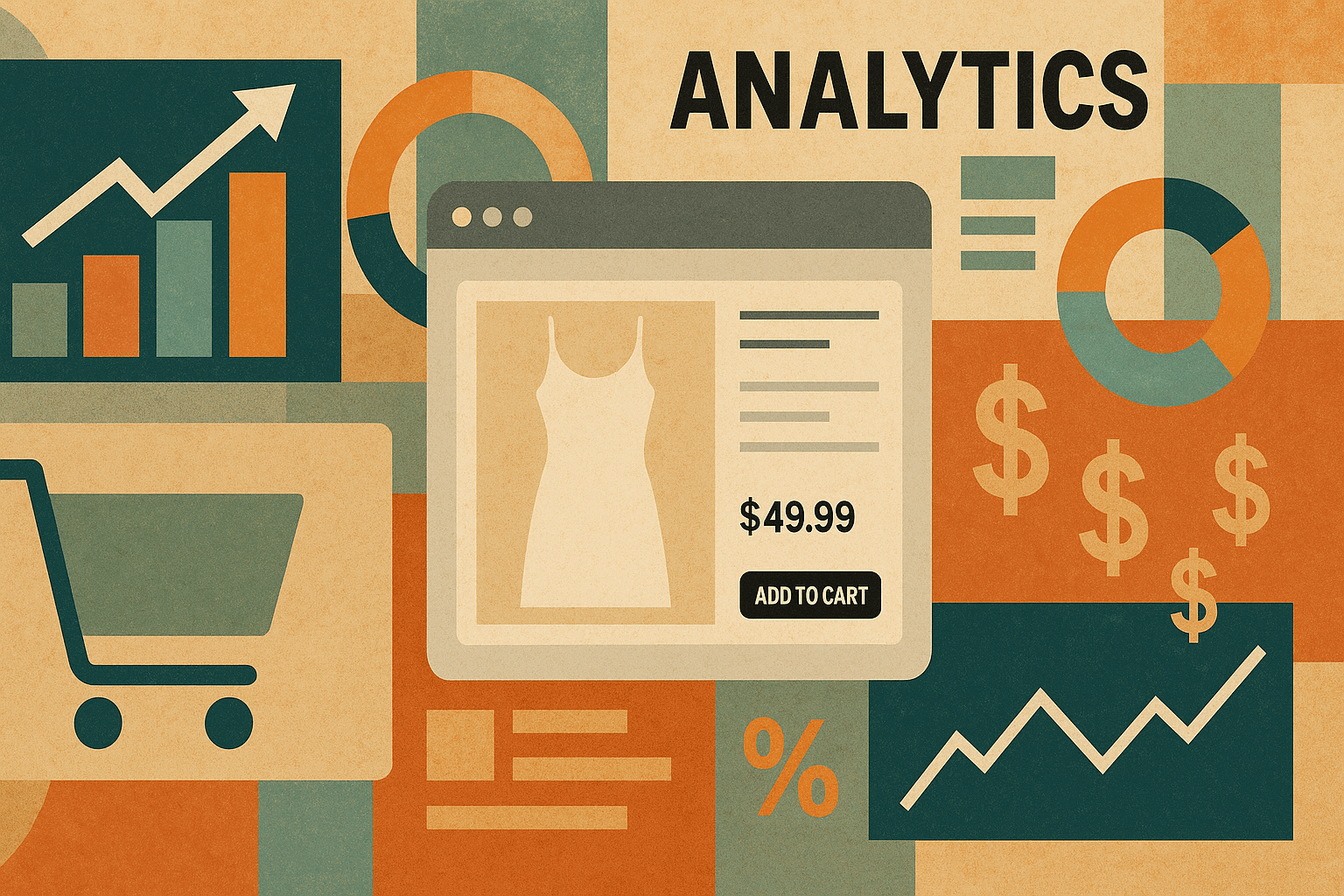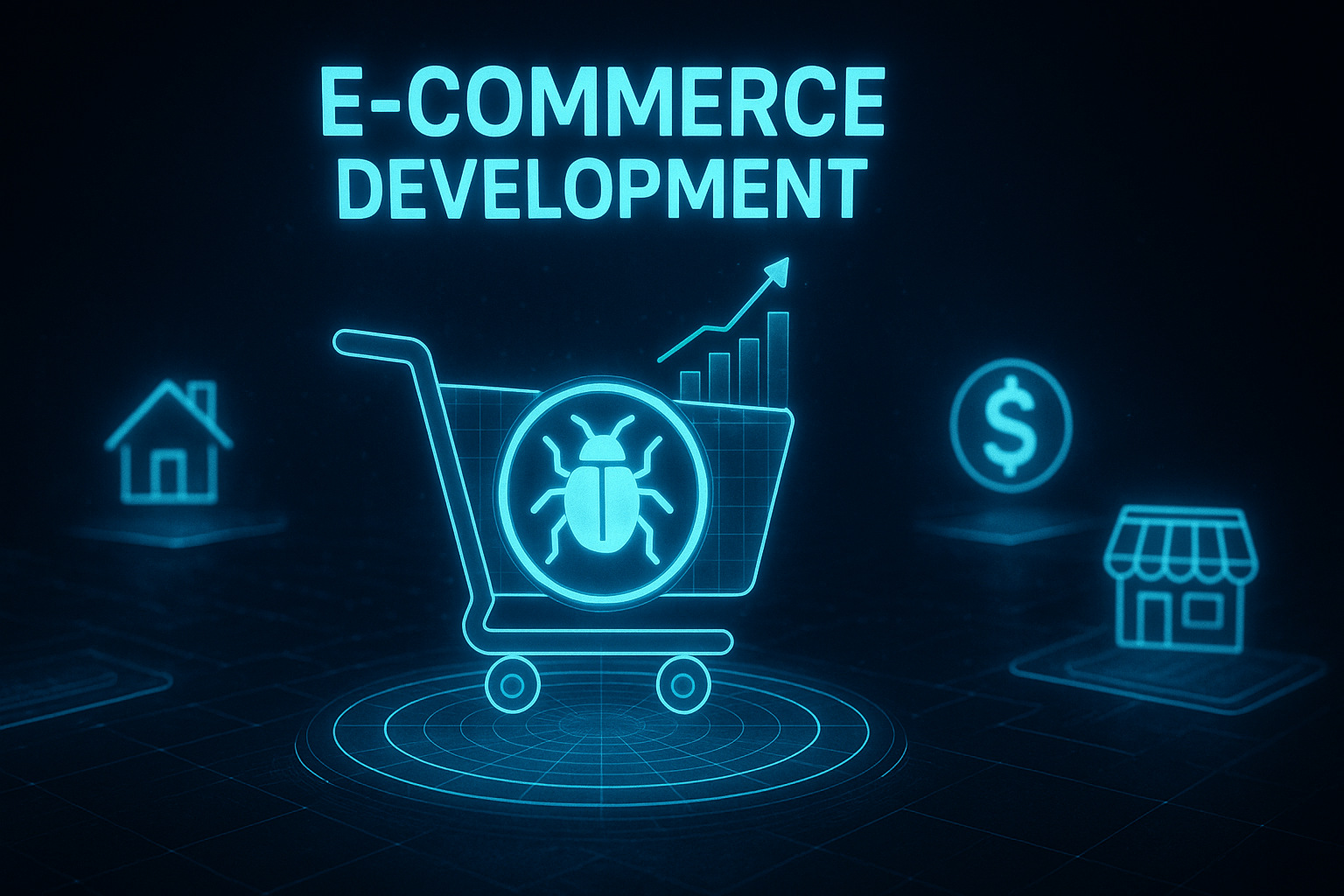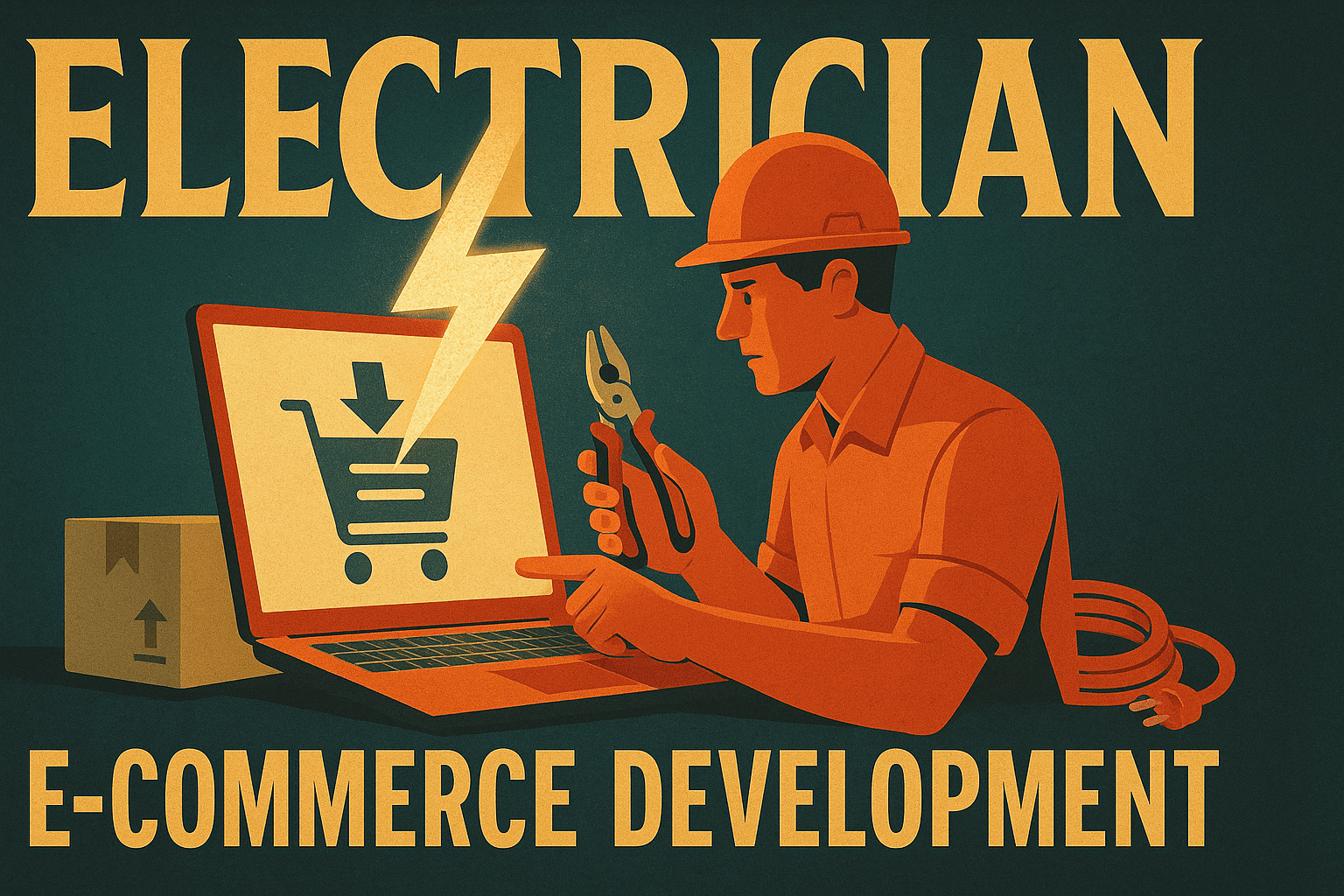E-commerce Development for Fashion Retail: Build Stores That Convert and Scale
by Design Delulu Editorial · October 20, 2025

Smart, fast, and measurable. Here's how e-commerce development helps fashion retail win.
Fashion retail is unforgiving. Shoppers expect instant loading, frictionless checkout, and product pages that answer every question before they ask. A slow site or confusing cart flow doesn't just cost you one sale—it erodes trust, damages brand perception, and sends customers straight to competitors who got the details right.
E-commerce development for fashion retail isn't about chasing trends or adding flashy features. It's about building systems that convert browsers into buyers and scale as your catalog grows. When done right, development work delivers measurable lift in conversion rates, average order value, and customer lifetime value. This guide breaks down the strategies, workflows, and optimizations that fashion retail brands use to win online—and how to implement them without burning months or budgets.

Why E-commerce Development Matters for Fashion Retail
Fashion retail operates in a uniquely competitive digital landscape. Your customers are visual, mobile-first, and comparison shopping across dozens of tabs. They expect high-resolution imagery, size guides, styling suggestions, and social proof—all delivered in under three seconds on any device.
Generic e-commerce platforms often fall short for fashion brands. Out-of-the-box templates struggle with large SKU counts, dynamic sizing matrices, seasonal inventory turnover, and the merchandising flexibility needed to showcase collections effectively. Custom development solves these challenges by creating:
- Product detail pages (PDPs) designed for conversion: Optimized image galleries, size selectors, inventory indicators, and add-to-cart flows that eliminate friction.
- Category and collection pages (PLPs) that merchandises intelligently: Filtering, sorting, quick-view functionality, and layout systems that guide discovery.
- Checkout experiences that minimize abandonment: Guest checkout options, address auto-complete, saved payment methods, and transparent shipping calculations.
- Performance architecture for large catalogs: Lazy loading, image optimization, CDN integration, and caching strategies that keep sites fast even with thousands of products.
- Analytics instrumentation that tracks what matters: Cart funnel analysis, cohort behavior tracking, product affinity mapping, and attribution modeling.
When these elements work together, the results compound. Faster page loads reduce bounce rates. Better PDPs increase add-to-cart rates. Streamlined checkout lifts order completion. Each optimization creates a measurable improvement that stacks with the others.
Core Components of Fashion E-commerce Development
Effective e-commerce development for fashion retail focuses on the highest-impact areas first. Here's where investment delivers the strongest returns:
Product Detail Pages (PDPs) That Sell
Your PDP is your digital sales floor. It needs to answer every objection, showcase the product from every angle, and make buying effortless. Key elements include:
- Image galleries with zoom and alternate views: Multiple angles, lifestyle shots, detail close-ups, and model imagery at various scales.
- Dynamic size and fit information: Size charts, fit guides, body measurements, and recommendations based on past purchases or stated preferences.
- Inventory visibility: Real-time stock levels, low-inventory alerts, back-in-stock notifications, and cross-warehouse availability.
- Social proof and validation: Customer reviews, ratings, user-generated photos, styling suggestions, and bestseller indicators.
- Smart recommendations: Complete-the-look suggestions, frequently bought together, alternative styles, and size alternatives.
Technical considerations: Mobile-first responsive design, fast image loading with WebP formats, accessibility for screen readers, and structured data markup for rich snippets in search results.
Checkout Optimization for Higher Completion Rates
Cart abandonment averages 70% in fashion retail. Most abandonment happens because checkout is too slow, too complicated, or requires account creation. Optimization strategies include:
- Guest checkout as the default path: Let customers buy first, create accounts later. Capture emails early for cart recovery.
- Single-page or accordion checkout: Minimize page loads and mental overhead. Show progress clearly.
- Address auto-complete and validation: Reduce typing, catch errors before submission, suggest corrections.
- Multiple payment options: Credit cards, digital wallets (Apple Pay, Google Pay, Shop Pay), buy-now-pay-later (Klarna, Afterpay), and saved payment methods for returning customers.
- Transparent shipping and tax calculation: Show total costs early, offer shipping options with estimated delivery dates, and display free shipping thresholds.
Back-end requirements: PCI-compliant payment processing, fraud detection integration, order management system connections, and real-time inventory reservation to prevent overselling.

Merchandising and Collection Management
Fashion retail thrives on curation. Your site architecture needs to support seasonal drops, limited editions, collaborations, and thematic collections without constant developer intervention. Development priorities:
- Flexible collection logic: Tag-based grouping, manual curation tools, automated rules (new arrivals, bestsellers, sale items), and cross-sell mechanics.
- Advanced filtering and sorting: Multi-select filters for color, size, style, price range, and material. Persistent filter states across sessions.
- Visual merchandising controls: Drag-and-drop product ordering, featured product pinning, promotional banner placement, and A/B testing capability.
- Search functionality: Autocomplete with product previews, synonym handling, typo tolerance, and faceted search results.
Bonus features: Lookbook builders, outfit creation tools, style quizzes that map to product recommendations, and personalized homepages based on browsing history.
Performance Optimization for Large Catalogs
Fashion brands often manage thousands of SKUs with multiple variants (size, color, material). Poor performance kills conversions. Core optimizations:
- Image optimization: Responsive images, lazy loading, modern formats (WebP, AVIF), CDN delivery, and compression without quality loss.
- Code splitting and lazy loading: Load only what's needed for the current page. Defer non-critical JavaScript and CSS.
- Caching strategies: Browser caching, server-side caching, edge caching via CDN, and cache invalidation for product updates.
- Database optimization: Indexed queries, materialized views for complex filters, pagination for large result sets, and query optimization.
- Third-party script management: Async loading for analytics, marketing pixels, and chat widgets. Remove unused scripts ruthlessly.
Target benchmarks: Under 2 seconds for initial load on 4G mobile, under 1 second for PDP interaction (size selection, color change), and Core Web Vitals scores in the green.
Analytics and Measurement Infrastructure
You can't optimize what you don't measure. E-commerce development should include robust analytics instrumentation from day one:
- E-commerce tracking: Product impressions, clicks, add-to-cart events, checkout steps, purchases, and refunds.
- Funnel analysis: Drop-off rates at each stage (PDP view → add to cart → checkout start → purchase completion).
- Cohort tracking: New vs. returning customer behavior, purchase frequency, average order value trends, and lifetime value projections.
- Product performance metrics: Views per product, conversion rate by SKU, revenue per product, and inventory turn rates.
- Attribution modeling: First touch, last touch, linear, time-decay, and position-based attribution across marketing channels.
Tool integration: Google Analytics 4, Segment or other CDPs, heatmapping tools (Hotjar, Clarity), session replay, and custom dashboards for executive visibility.
The Fashion E-commerce Development Process
Successful e-commerce projects follow a structured approach that balances speed with thoroughness. Here's the proven workflow:
Phase 1: Discovery and Goal Setting (1-2 Weeks)
Before any code gets written, align on outcomes, constraints, and success metrics. Key activities:
- Business objectives: Revenue targets, conversion rate goals, average order value benchmarks, customer acquisition costs.
- User research: Customer interviews, usability testing on existing site, competitive analysis, and friction point identification.
- Technical audit: Current platform assessment, integration requirements, data migration needs, and performance bottlenecks.
- Stakeholder alignment: Define decision-makers, approval workflows, feedback loops, and communication cadence.
Deliverable: A project brief that documents scope, timeline, budget, success metrics, and key assumptions. This becomes the north star for the engagement.
Phase 2: Blueprint and Strategy (1-2 Weeks)
Map the architecture, design system, measurement plan, and development roadmap. Focus areas:
- Information architecture: Site map, navigation structure, taxonomy, URL hierarchy, and internal linking strategy.
- Wireframes and user flows: Low-fidelity layouts for key templates (PDP, PLP, cart, checkout), annotated with functionality notes.
- Technical architecture: Platform selection or optimization, hosting infrastructure, CDN strategy, payment gateway integration, and third-party service connections.
- Measurement framework: Event taxonomy, data layer specification, tracking implementation plan, and dashboard mockups.
- Design system foundations: Typography, color palette, spacing scale, component library, and responsive breakpoints.
Deliverable: A comprehensive blueprint document that guides development. Includes technical specifications, design mockups, and measurement plans.
Phase 3: Build and Launch (4-8 Weeks)
Execute the plan with disciplined sprints, regular check-ins, and continuous QA. Development workflow:
- Environment setup: Development, staging, and production environments with version control and automated deployments.
- Component development: Build reusable components (product cards, filter panels, cart drawers) that maintain consistency across templates.
- Template implementation: Homepage, collection pages, product pages, cart, checkout, and transactional flows.
- Integration work: Connect payment processing, shipping calculators, inventory management, CRM, email marketing, and analytics.
- QA and testing: Cross-browser testing, mobile device testing, accessibility audits, load testing, and user acceptance testing.
- Launch preparation: DNS configuration, SSL certificates, redirect mapping, 301 redirects for changed URLs, and rollback plans.
Best practices: Ship in small increments when possible. Test on staging with real product data. Involve stakeholders in UAT. Document everything for future maintenance.
Phase 4: Optimize and Iterate (Ongoing)
Launch is the starting line, not the finish. Post-launch optimization creates compounding returns:
- Performance monitoring: Track Core Web Vitals, server response times, error rates, and uptime. Set alerts for anomalies.
- Conversion analysis: Identify friction points in the funnel. Run A/B tests on high-impact areas (CTA copy, button colors, checkout fields).
- User feedback collection: Post-purchase surveys, on-site feedback widgets, customer service ticket analysis, and social listening.
- Feature iteration: Prioritize enhancements based on data. Double down on what drives results. Deprecate what doesn't.
- Quarterly reviews: Revisit goals, assess progress, reallocate budget, and reset priorities based on business evolution.
Optimization mindset: Every page, every flow, every feature has a KPI. Measure everything. Test relentlessly. Compound small wins into significant gains.

Best Practices for Fashion Retail E-commerce
These strategies separate high-performing fashion e-commerce sites from the rest:
Mobile-First, Always
Over 70% of fashion retail traffic comes from mobile devices. Design for small screens first, then enhance for desktop. Key considerations: thumb-friendly tap targets, simplified navigation, fast loading on cellular networks, and mobile-optimized images.
Prioritize the Highest-Impact Work First
Don't boil the ocean. Focus on the pages and flows that drive the most revenue. Typically: homepage, top-performing PLPs, bestselling PDPs, and checkout. Optimize these before moving to lower-traffic areas.
Pair Creative with Measurement
Every design decision should tie to a metric. Beautiful is good; beautiful and high-converting is better. Tag every asset, track every interaction, and use data to inform creative iteration.
Build Systems, Not One-Offs
Templates and component libraries let you scale quickly. Instead of custom-designing every product page, create flexible templates that accommodate various product types. Invest in systems that enable speed.
Speed Is a Feature
Every 100ms of load time costs conversions. Treat performance as a core feature, not an afterthought. Establish performance budgets and defend them ruthlessly during development.
Test Everything
Assumptions kill conversions. A/B test layout changes, messaging variations, checkout flows, and merchandising strategies. Let data decide. Even small lifts (2-5% conversion improvement) compound significantly over time.
Close the Loop with Regular Reviews
Weekly performance check-ins keep teams aligned and accountable. Quarterly strategic reviews ensure you're still working toward the right goals. Adapt as the business evolves.
Industry-Specific Tips for Fashion Retail
Fashion retail has unique needs that generic e-commerce advice often misses. Here's what works specifically for fashion brands:
Map Content to the Fashion Buyer Journey
Fashion shoppers move through distinct stages: inspiration (browsing trends, discovering styles), consideration (comparing options, reading reviews), and decision (selecting size, completing purchase). Your site should support all three stages with appropriate content, navigation, and calls-to-action.
Use Social Proof Early and Often
Fashion is inherently social. Feature customer photos, style influencer partnerships, and real reviews prominently. Show bestseller indicators, trending items, and "as seen on Instagram" collections. Build trust through transparency.
Optimize for Visual Search and Discovery
Fashion shoppers often start with a vague aesthetic in mind. Support visual browse behaviors with strong imagery, intuitive filtering, and inspiration-focused collection pages. Consider implementing visual search (upload a photo, find similar items).
Seasonal Agility Matters
Fashion moves in seasons and trends. Your development approach needs to accommodate rapid merchandising changes, limited-edition drops, and flash sales without requiring engineering intervention. Build flexibility into collection management and promotional tools.
Measure Against a Single Source of Truth
Consolidate metrics into one dashboard that everyone uses. Sales, marketing, and product teams should reference the same numbers. Reduces confusion, speeds decisions, and keeps teams accountable to shared goals.
Ship Small, Test Fast, Compound Wins
Don't wait for the perfect solution. Launch incremental improvements, measure impact, iterate based on results. Small wins stack into significant competitive advantages over time.
Common Pitfalls to Avoid
Even experienced teams make these mistakes. Learn from others:
- Over-customization: Unique features feel exciting but create maintenance nightmares. Stick to proven patterns unless you have strong data supporting custom work.
- Ignoring mobile performance: Desktop metrics look great, but mobile shoppers bounce. Test on real devices with throttled connections.
- Launching without analytics: If tracking isn't in place on day one, you'll never have baseline data. Instrument before you launch.
- Skipping QA on edge cases: That obscure browser or device? Someone's using it. Test comprehensively or plan for support headaches.
- Feature bloat: More features don't equal more conversions. Complexity kills. Simplify ruthlessly.
- Neglecting post-launch optimization: The site that launches isn't the site that wins long-term. Budget for continuous improvement.
Technology Stack Considerations
Platform choice matters, but execution matters more. Common approaches for fashion retail:
Headless Commerce
Decouples the front-end from the back-end commerce engine. Offers maximum flexibility and performance. Best for brands with complex requirements, large catalogs, or unique user experiences. Trade-offs: higher development cost, longer time to market, requires more technical expertise.
Composable Commerce
Mix and match best-of-breed services (commerce engine, CMS, search, personalization) through APIs. Balance flexibility with speed. Best for growing brands that need scalability without full headless complexity. Trade-offs: integration overhead, vendor coordination, potential API limitations.
SaaS Platforms (Shopify, BigCommerce, etc.)
All-in-one solutions with extensive app ecosystems. Fast time to market, predictable costs, and strong out-of-the-box features. Best for brands that fit platform patterns and value speed over customization. Trade-offs: less flexibility, app dependencies, platform lock-in.
Custom Builds
Full control over every aspect. Best for enterprise brands with specific requirements that platforms can't accommodate. Trade-offs: highest cost, longest timeline, significant maintenance burden.
Recommendation: Start with the least-custom solution that meets your needs. Graduate to more complex approaches as your business scales and requirements evolve.
Measuring Success: KPIs That Matter
Track metrics that tie directly to business outcomes. For fashion e-commerce, prioritize:
- Conversion rate: Overall site conversion, PDP-to-cart rate, cart-to-checkout rate, checkout completion rate.
- Average order value (AOV): Track by traffic source, customer segment, and product category. Look for bundling and upsell opportunities.
- Revenue per session: Combines traffic quality and conversion effectiveness. More actionable than pageviews alone.
- Customer acquisition cost (CAC) vs. lifetime value (LTV): Unit economics determine profitability. Aim for LTV:CAC ratio of 3:1 or higher.
- Return customer rate: Fashion thrives on repeat purchases. Track repurchase frequency and time between orders.
- Cart abandonment rate: Industry benchmark is ~70%. Every point reduction delivers significant revenue lift.
- Site speed metrics: Largest Contentful Paint (LCP), First Input Delay (FID), Cumulative Layout Shift (CLS). Google Core Web Vitals impact both conversions and SEO.
Support metrics: product views, search usage, filter engagement, review submission rate, email capture rate, and customer service ticket volume.
Working with an E-commerce Development Partner
Choosing the right development partner accelerates results and reduces risk. Look for:
- Fashion retail expertise: Prior work with apparel, accessories, or footwear brands. Understanding of industry-specific challenges (sizing, seasonality, visual merchandising).
- Performance track record: Case studies with measurable results. Before-and-after metrics. Client references.
- Technical capabilities: Platform expertise aligned with your needs. Integration experience. Performance optimization skills.
- Strategic thinking: Partners who ask "why" before "how." Focus on business outcomes, not just technical deliverables.
- Clear communication: Regular updates, transparent timelines, proactive problem-solving. Avoid partners who go dark between milestones.
- Post-launch support: Maintenance plans, optimization programs, and ongoing partnership vs. one-time project mentality.
Red flags: Lack of relevant portfolio work, vague timelines, reluctance to discuss pricing, over-promising results, and poor communication during sales process.
Budget and Timeline Expectations
Fashion e-commerce projects vary widely in scope and complexity. General guidelines:
- Small optimization project (PDP redesign, checkout streamlining): $15K-$40K, 4-6 weeks.
- Mid-size build (custom Shopify theme, integration work, analytics setup): $40K-$100K, 6-10 weeks.
- Large-scale project (headless commerce, custom platform, complex integrations): $100K-$500K+, 3-6 months.
Factors that increase cost and timeline: Large product catalogs (1,000+ SKUs), complex inventory management, international expansion, custom features, extensive integrations, and enterprise security/compliance requirements.
Smart budgeting: Start with core functionality. Launch lean. Reinvest profits into optimization and feature expansion. Avoid the temptation to build everything upfront.
Future-Proofing Your Fashion E-commerce Site
Technology evolves rapidly. Build with adaptability in mind:
- API-first architecture: Decouple systems through clean APIs. Makes swapping components easier as better solutions emerge.
- Modular design systems: Component libraries that can evolve without complete redesigns. Design tokens for consistent theming.
- Progressive enhancement: Core functionality works everywhere. Enhanced experiences layer on for capable browsers and devices.
- Documentation: Comprehensive technical docs, code comments, and runbooks. Future developers (or you in six months) will thank you.
- Regular audits: Quarterly technical debt assessments. Proactive maintenance prevents emergency rewrites.
The best e-commerce sites aren't rebuilt every few years—they evolve continuously through incremental improvements and smart architectural decisions.
Frequently Asked Questions
Let’s level up your Fashion Retail business
Need services that actually move the needle for Fashion Retail? See our approach, pricing, and timelines—then book a quick call.
Additional Resources
- Schedule Your E-commerce Strategy Call
Talk through your fashion retail challenges, timeline, and goals in a 30-minute consultation. We'll assess your current site, identify quick wins, and outline a development roadmap with pricing and deliverables tailored to your business.
- View Our Fashion E-commerce Portfolio
See real results from fashion retail brands we've helped grow. Case studies include conversion lifts, performance improvements, and before-after metrics from e-commerce development projects across apparel, accessories, and footwear retailers.
- Free Fashion E-commerce Tools & Resources
Access calculators, templates, and guides for fashion retail e-commerce. Includes conversion rate benchmarking, checkout optimization checklists, performance audit templates, and KPI tracking dashboards—all free and ready to use today.
Related Reading

Professional e-commerce development for photographers & videographers. Sell prints, packages & digital downloads with optimized product pages, smart checkout flows & analytics that track what sells.

Professional e-commerce development tailored for pest control businesses. Boost online sales with optimized checkout, catalog management, and conversion tracking.
